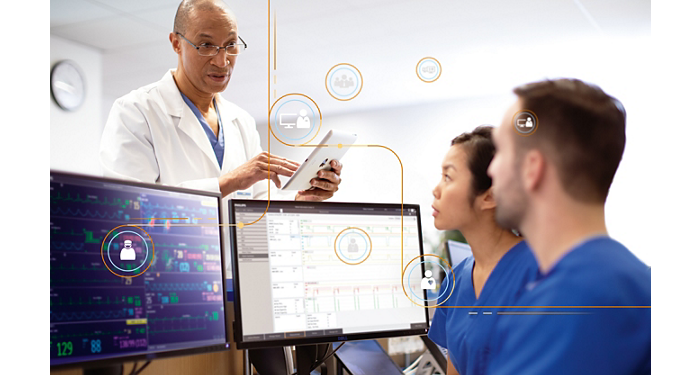With clinical context in their hands, caregivers at Isala Women and Children’s Hospital can make an informed decision to respond to an alarm, escalate to a colleague or rule it non-actionable.
Alarm management
Analysis, consulting, training and reporting services paired with configurable alarm technologies and tailored to your organization.
Visual and audible alarms in critical care environments can be a contributor to medical errors, and can cause unnecessary stress and burden on caregivers and patients.1 Some caregivers are flooded with 150 to 350 alarm conditions per patient per day2. The result can include staff burnout and lost productivity, as well as unnecessary patient transfers to the ICU and extended lengths of stay.3

Solution components
Patient monitoring
Services
Supplies and consumables
1 Ruskin KJ, Hueske-Kraus D. Alarm fatigue: impacts on patient safety. Curr Opin Anaesthesiol. 2015 Dec;28(6):685-90 Wilken M, Hüske-Kraus D, Klausen A, et al. Alarm fatigue: causes and effects. Stud Health Technol Inform. 2017;243:107-111. ECRI Top 10 Technology Risks 2017-18. 2 Keith J. Ruskina and Dirk Hueske-Kraus, Alarm fatigue: impacts on patient safety, Volume 28, Number 6, December 2015
4 Multicentric study of monitoring alarms in the adult intensive care unit (ICU): a descriptive analysis”, Intensive Care Medicine, 1999, V: 12 E:12, pp. 1360-1366. 5 Konkani A, Oakley B, Bauld TJ: Reducing hospital noise: a review of medical device alarm management. Biomed Instrum Technol 2012, 46(6):478-87 6 Görges M, Markewitz BA, Westenskow DR: Improving Alarm Performance in the Medical Intensive Care Unit Using Delays and Clinical Context. Anesth. Analg. 2009, May 1, 108: 1546-1552
8 AAMI Foundation. Clinical alarm: 2011 Summit convened by AAMI, FDA, TJA, ACCE and ECRI Institute. 2011. s3.amazonaws.com/rdcms-aami/files/production/public/FileDownloads/Summits/2011_Alarms_Summit_publication.pdf2016.
9 ECRI Institute. ECRI Institute Announces Top 10 Health Technology Hazards for 2015. www.ecri.org/press/Pages/ECRI-Institute-Announces-Top-10-Health-Technology-Hazards-for-2015.aspx2016.
10 Sendelbach S, Funk M. Alarm fatigue: a patient safety concern. AACN Adv Crit Care 2013;24:378–86. 10.1097/NCI.0b013e3182a903f9 www.ncbi.nlm.nih.gov/pubmed/24153215
11 Kowalczyk L. Suit over cardiac monitor settled - MGH patient died despite alarms. Boston Globe 2011. 12 Kowalczyk L. ‘Alarm fatigue’ a factor in 2d death - UMass hospital cited for violations. Boston Globe 2011. 13 Drew BJ, Harris P, Zègre-Hemsey JK, et al. Insights into the problem of alarm fatigue with physiologic monitor devices: a comprehensive observational study of consecutive intensive care unit patients. PLoS One 2014;9:e110274
14 1371 journal pone 0110274 www.ncbi.nlm.nih.gov/pmc/articles/PMC4206416/
15 AAMI Foundation’s HTSI (Healthcare Technology Safety Institute): Using Data to Drive Alarm System Improvement Efforts: The Johns Hopkins Hospital Experience. Johns Hopkins Hospital 2012 16 Welch J: An evidence-based approach to reduce nuisance alarms and alarm fatigue. Biomed Instrum Technol 2011, Spring;Suppl:46-52 17 Imhoff M, Kuhls S, Gather U et al.: Clinical relevance of alarms from bedside patient monitors. Crit Care Med 2007, 35(suppl):A178 18 Just a nuisance? Alarm management white paper General disclaimer: Results of customer testimonies are not predictive of results in other cases, where results may vary.




